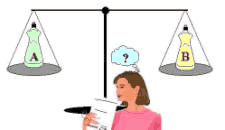![]() Receive new posting via RSS feed. >Click the icon on the left to subscribe.
Receive new posting via RSS feed. >Click the icon on the left to subscribe.
(Or right click the icon to copy and paste the link into your rss reader)
 Curious But Real: Effects From Fast Forwarded Ads
Curious But Real: Effects From Fast Forwarded Ads
by Max Sutherland
Latest evidence confirms that fast-forwarded TV ads are undervalued. They have some very curious…but real effects.
In today’s world of DVD recorders, when we watch TV programs, we often fast forward through the commercials. Advertisers have a more limited ability to engage our minds in continuous 30-second messages and hence the scramble is on to find alternative delivery vehicles (YouTube, viral ads, product placement etc).
But are fast-forwarded ads entirely without impact? After all, a fast-forwarded ad is somewhat akin to driving past a billboard or flicking through an ad in a magazine. So why would we expect that they have no effect at all?
There is little doubt that we undervalue fast-forwarded commercials … and have done for a long time. We knew a decade ago that they do have an effect and back in 1998 I first wrote about how to use fast-forwarded commercials.1
Curiously, research on their impact still remains sparse and very few studies have been conducted in the interim. Two important studies have however been published recently and both have supported the conclusions that I communicated back then. In addition they have identified another curious effect.
What Can Fast Forwarded (Zipped) Ads do?
In 1998 it was clear from the original study2 that with fast-forwarded ads, very little is communicated. There is little or no new learning. Yet, at the same time it was also apparent that when ads, seen previously at normal speed are seen again at fast speed, this is different. Our minds tend to fill in the mental gaps with memories and associations.
The research found that when ads are already familiar to us from seeing them at normal speed, that seeing them in fast-forward mode serves to remind us of:
a) The brand and
b) Previously watched instances of the ad.
In the original study, respondents watched a pre-recorded program complete with commercials. The next day they watched another pre-recorded program where the commercials were fast-forwarded under the pretext of saving time. The respondents were then given a surprise test to measure spontaneous ad recall and ad recognition. Familiar ads played in fast -forward were able to influence advertiser (brand name) recall and recognition as well as recall of the ad’s primary message attribute.
Limited though such reminders are, we frequently deploy various, other support-media (such as billboards and print media) to generate just such reminders. So why discount the effects when they come from fast-forwarded ads?
But Wait…There’s More…
Some more recent research into fast-forwarded ads suggests that they probably have more effect than driving past a billboard or flicking through a magazine ad. This is because of what Eric Du Plessis, in his Admap study, published this month (September 2007), calls ‘inadvertent attention’.3
As he points out: “to fast-forward the ads you need to give the television total attention. It is very difficult to stop at the end of the commercial break…” The irony is that in the process of trying to avoid TV ads we are giving more attention to them than we do when we are just ignoring them.
The concept of ‘inadvertent attention’ is curious and somewhat counter-intuitive, until you think about it. Partially that accounts for why most advertisers may have been dismissive of fast-forwarded ads. The other thing though, is that their effects become visible only by carefully designed researched
And There’s Still More? … Emotional Impact
The data from the Du Plessis study and the data from a 2006 study by Goode4 (for Sky TV) confirm the original reminder effects but they also reveal an emotional impact for ads seen before. When they are viewed in fast-forward, the emotional response of how much we liked the ad when we saw it at normal speed looks to be fleetingly retriggered.
We can see this as yet another type of reminder effect. As Du Plessis says: “What is likely is that if someone has seen an advertisement before, and formed an emotional response to it, then this emotional response (as part of the whole ad) is recalled at the time when the fast-forwarded ad is interpreted”.
It may be though, that only the emotional response gets triggered, even without explicitly recalling any of the content of the ad. According to Goode we retain the emotional nature of our past experiences (in implicit memory) and this gets retriggered on fast forwarding.5
Goode’s data suggests that in re-triggering the emotional (ad-liking), it builds on the viewer’s initial, emotional response and causes a ‘knock on’ effect. That is, seeing the ad again later at normal speed is likely to engage a more positive response than it would, if we had not had the fast-forward exposure.
Now I am the first to admit that this sounds a bit of a stretch. However, a similar effect has been found with web banner ads that would support this contention.
Web Ads
When we read a publication (like the New York Times) online, we are exposed incidentally to ads on the same page. We probably don’t notice them and we probably wouldn’t even recognize that we had seen them. Yet in spite of this, it has been consistently shown that readers of the page are subsequently able to identify that brand, and perceive the ad, faster in the future as a result of the exposure (i.e. it increases perceptual fluency) without awareness.6 It tunes up the mental processes associated with identifying the brand, and mentally registering that ad, in the future.
Readers not only identify the brand more quickly (important for the pop-out effect in cluttered product displays) but also there is an emotional, ‘knock-on’ effect imparted to the ad. In any subsequent, conscious reaction to that web ad, people react more favorably to it. The effect is not great but people do like the ad more than they would, had they not had the prior, incidental exposure. Importantly, this ‘knock-on’ response to the ad becomes progressively more positive as people are exposed (without much awareness) to additional repetitions of it.
So even though readers are unaware of it, their liking of a web ad marginally escalates after incidental exposure to it. And with TV ads too, the viewer’s emotional response to them appears to be reinforced, again without awareness, by seeing them in fast-forward (but only if they have been seen before at normal speed). Is there a common mechanism at work?
Familiarity
My money is on familiarity. It has long been known that ‘mere exposure’ is able to induce a sense of familiarity and we feel more comfortable with familiar things. Other things being equal, familiarity in itselfis experienced as emotionally positive.7,8 A familiar brand, like a familiar ad is, in a sense, ‘easier on the mind’.9 (Another vein of research shows that we seem to cut more slack and tolerate advertising repetition better for brands that are familiar.10)
There is little doubt that a greater sense of familiarity is linked with positive feelings and that it can be imparted without awareness. It occurs when we encounter things incidentally or when we see things in fast-forward or indeed at subliminal, speeds.
So, here’s another curious thought. Inadvertent attention means focusing attention on a stream of rapidly flashing ad content that is almost akin to subliminal-speed exposure.11 Exaggerated claims made for subliminal ads are a hoax (see my column Subliminal Advertising Like the Energizer Bunny Keeps Going and Going), but at the same time, there is no doubt that fast-speed flashes can have some limited effects. Conveying a sense of greater familiarity is one of them.
Final Speculation: Mind on High?
Since we are pointing to some weird mechanisms underlying the effect of fast-forwarded ads, let me chance my arm to speculate on an additional mechanism perhaps lurking here. It is what I call the ‘mind on high’ effect.
As I pointed out in another column (Mind On High, Thoughts on Fast Forward and Brands on Speed), our minds react with a curious response to speeding them up. Research has shown in a whole variety of situations, that this can strangely produce a mild ‘high’ and a greater liking for the material that is speeded up.
When fast-forwarding ads, we have to focus on the speeded up content to know when to hit the stop button if we want to avoid over-shooting and rewinding. Our mental processes (of identification and recognition) are pushed to a faster-pace for us to be able to do this.
Could this also be a mechanism underlying the impact of fast-forwarded ads? We have already seen that fluency (which means speeded up mental processing) generates positive emotion with web ads. Perhaps it is too much to call this ‘a mild high’ but the evidence is that it clearly influences liking of the ad content, as well as subsequent cognitions.
Conclusion
All this supports Goode’s contention that seeing a familiar ad in fast forward can increase liking for both the ad and the brand: “They act as a catalyst to induce positive associations with the brand, which were seeded when the ad was first seen.”
All three studies have confirmed reminder-reinforcement effects and the more recent studies have unearthed emotional effects as well. These effects:
a) Not only seem to wash-over onto the brand but also
b) Seem to tweak viewer’s reactions when they see the ads again at normal speed.
We are now paused, waiting for more studies like these to emerge. NBC is dipping a toe in the water (check it out here). However, it is clear already from the few studies that have been done, that fast-forwarded TV ads, like web ads, are under-valued.
 Yes, the effect of each zipped exposure is probably small, compared to when the same ads engage us at normal speed for 30 seconds ormore. But even a small effect, a feather, can swing the balance of choice if everything else weighs equal. Furthermore small feathers can build over time, by repetition (just like kids grow imperceptibly by a tiny amount each day).
Yes, the effect of each zipped exposure is probably small, compared to when the same ads engage us at normal speed for 30 seconds ormore. But even a small effect, a feather, can swing the balance of choice if everything else weighs equal. Furthermore small feathers can build over time, by repetition (just like kids grow imperceptibly by a tiny amount each day).
It is time to stop being cavalier in our dismissal of fast-forwarded ads. Every snowflake in an avalanche pleads not guilty. Fast-forwarded ads clearly have some very real and very curious effects.
Download pdf copy of "Curious But Real: Effects From Fast Forwarded Ads - Sept 2007"
Notes:
1. Sutherland M., Learn to communicate with zipped commercials. Australian Professional Marketing, October/November 1998
2. Robert Gilmore and Eugene Secunda, “Viewing in the Distracted Environment: A VCR Zipping Study”, Advertising Research Foundation Workshop on Electronic Media, 1991
3. Du Plessis, E. (2007). " DVRs, fast-forwarding and advertising attention." Admap (September).
4. Goode, A. (2006). "What happens at x30 fast-forward?" Admap (January): 46-48.
5. Goode, A. (2006). "What happens at x30 fast-forward?" Admap (January): 46-48.
6. Fang, X., S. Singh, et al. (2007). "An examination of different explanations for the mere exposure effect." Journal of Consumer Research 34(June).
7. Lee, A. Y. and A. A. Labroo (2004). "The Effect of Conceptual and Perceptual Fluency on Brand Evaluation." Journal of Marketing Research 41(2): 151-165.
8. Johar, G. V., D. Maheswaran, et al. (2006). "MAPping the Frontiers: Theoretical Advances in Consumer Research on Memory, Affect, and Persuasion." Journal of Consumer Research 33: 139-149.
9. Winkielman, P., J. Halberstadt, et al. (2006). "Prototypes Are Attractive Because They Are Easy on the Mind." Psychological Science 17(9): 799-806.
10. Campbell, M. C. and K. L. Keller (2003). "Brand Familiarity and Advertising Repetition Effects." Journal of Consumer Research 30(2): 292-304.
11. Thanks to Eric Du Plessis for making this connection between the two (in private correspondence, May 2007).


